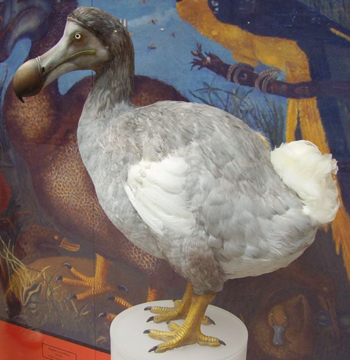Using fossils to explain island bird extinctions...
 Biodiversity,
Biodiversity,  Birds
Birds  Dodo reconstruction (Raphus cucullatus) at Oxford University Museum of Natural History. Image credit, Ballista.A new study in the journal Conservation Biology uses paleoecology to identify the factors that make island birds prone to extinction.
Dodo reconstruction (Raphus cucullatus) at Oxford University Museum of Natural History. Image credit, Ballista.A new study in the journal Conservation Biology uses paleoecology to identify the factors that make island birds prone to extinction.
Reading a listing of known extinct birds is enough to make your heart sink. Most notable is the disproportionately high number of island species. From the Cuban red macaw to the Hawaiian rail, from the King Island emu to the dodo, island birds have faced a staggering rate of extinction.
But can we learn from past extinction events to help us conserve the island bird populations that remain today, many of which are seriously threatened?
This is where the science of paleoecology can come in handy. Paleoecologists uses fossils to help us understand what ecosystems were like in the past.
Study author Alison Boyer looked at extinct and existing bird populations in a segment of the Pacific islands by analyzing historical and paleoecological data (i.e. fossil records). She wanted to find out what characteristics of island birds and their habitat explain extinction events.
The study found that extinction was best explained by intrinsic characteristics of birds as opposed to external variables such as island size and isolation, deforestation, introduced species, etc. Specifically, the following intrinsic qualities were most strongly associated with extinction:
1) Large body size
2) Flight ability - 91% of flightless birds analyzed went extinct.
3) Endemism - 50% of species or genera endemic to a single island went extinct.
4) Dietary categories - Fugivory, granivory, herbivory, and omnivory were associated with high extinction risk in small-bodied endemics.
These findings are consistent with likely human causes of avian extinction on islands. Boyer writes,
"High incidence of extinction in large flightless birds is consistent with a hypothesis of direct exploitation by people because human foragers tend to target large, profitable prey. Classic macroecological relationships show that large body size constrains reproductive rate and population density and, hence, total population size on an island, which makes large species more vulnerable to extinction. Endemism broadly reflects range size, habitat specialization, and naivete to predators, and endemics often fall victim to anthropogenic extinctions."
Boyer found that about one-third (448 out of 1256) of the tropical Pacific island bird populations considered in the study have been lost since human colonization. Of these, 350 were lost prior to European contact in the 1800's while 98 have become extinct afterwards. Interestingly, the characteristics that explain extinction were fairly consistent from the period of human colonization to the present.
The study also found that these same intrinsic characteristics that explain past extinction also predict reasonably well which island species are currently listed as threatened on the Red List of the International Union of Concerned Scientists.
This is where Boyer's approach can be particularly helpful. Her model incorrectly predicted threatened status for some species such as the cloven feathered dove and the New Caledonian cuckooshrike. The study findings suggest that these species may nonetheless be at a relatively high risk for future extinction and therefore merit closer attention.
--Reviewed by Rob Goldstein
BOYER, A. (2009). Consistent Ecological Selectivity through Time in Pacific Island Avian Extinctions Conservation Biology DOI: 10.1111/j.1523-1739.2009.01341.x




Reader Comments